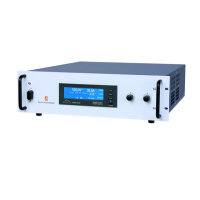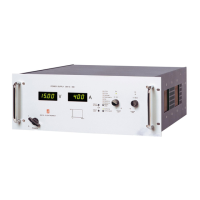Ethernet & Sequencer Programming SM15K
29 / 44 DELTA ELEKTRONIKA B.V. rev. Aug. 2019
6.3 Sequence control by commands
6.3.1 Read the Catalog
The catalog contains all the programmed sequences. To read the catalog send the query:
Syntax : PROGram:CATalog?<term>
The SM15K returns a list of the names of all sequences, separated by linefeeds.
The end of the catalog is indicated by an extra <nl>.
In case of no sequences available, the SM15K only returns one <term>.
Example: PROG:CAT?<term> answer: WAVE1<nl>PROCESS4<nl>RAMPUP<nl><term>
6.3.2 How to create or select a Sequence
To select an existing sequence or to create a new one, send the command:
Syntax: PROGram:SELected:NAMe<sp><string><term> string may contain the characters
A-Z, 0-9 and + (max. 16 characters) The first character of string has to be an A-Z.
To read which sequence is selected, send the query:
Syntax: PROGram:SELected:NAMe?<term>
The SM15K returns the name of the selected sequence, followed by a <term>. Or, in case of no selection,
only <term>. Sequence names are not case-sensitive (during selection), but are stored in memory with
upper case.
6.3.3 Upload a Sequence to SM15K (PC → PS)
First select/create a sequence, then upload the new steps by the command:
Syntax: PROGram:SELected:STEp<sp><NR1><sp><command+operand(s)><term>
<NR1> = 1 to 2000. Steps do not have to be programmed in order, but already existing steps will be
overwritten when reselected.
For example: PROG:SEL:STEp<sp>21<sp>CJNE<sp>#A,3,15<term>
Download a Sequence from SM15K (PS → PC)
After a sequence is selected, the steps can be downloaded one by one, using the query:
Syntax: PROGram:SELected:STEp<sp><NR1>?<term>
The SM15K returns <step number><sp><command+operand(s)><term>.
If the queried step doesn't exist, the SM15K returns <term>.
The SM15K returns the complete sequence when it receives the query:
Syntax: PROGram:SELected:STEp<sp>?<term>
The answer from the SM15K will be:
<1><sp><command+operand(s)><nl><2><sp><command+operand(s)><nl> and so on.
After the last step the SM15K sends <term> as a terminator.
6.3.4 Delete a Sequence
After a sequence is selected, it can be removed from the catalog by:
Syntax: PROGram:SELected:DELete<term>
To clear the whole catalog and delete all the sequences, including their assignments, send:
Syntax: PROGram:CATalog:DELete<term>
6.3.5 Start a Sequence
If a sequence is selected, it can be started by the command:
Syntax: PROGram:SELected:STAte<sp>RUN<term>
The sequence will start at step 1. The RUN command will automatically initiate a sequence Build when the
sequence is not yet build, or modified after an earlier build.
6.3.6 Pause a Sequence
If a sequence runs, it can be paused by the command:
Syntax: PROGram:SELected:STAte<sp>PAUSe<term>
If the sequence is paused, it can be continued after sending the command:
Syntax: PROGram:SELected:STAte<sp>CONTinue<term>
6.3.7 Step through a Sequence
If a sequence is selected, it is possible to manually step through the program (during any mode) by:
Syntax: PROGram:SELected:STAte<sp>NEXT<term>
This command executes the next step and turns in mode PAUSE. If the current step contains a Wait
instruction and it is not finished yet, the sequencer ignores the Wait instruction.
For debugging the sequence this command can be very handy.

